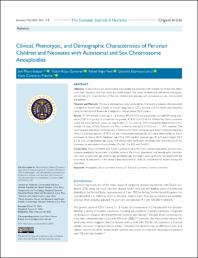Clinical, Phenotypic, and Demographic Characteristics of Peruvian Children and Neonates with Autosomal and Sex Chromosome Aneuploidies

View/
Download
(application/pdf: 1.476Mb)
(application/pdf: 1.476Mb)
Date
2023-02-28Author(s)
Moya-Salazar, Jeel
Rojas-Zumaran, Víctor
Vega-Vera, Rafael
Espinoza-Lecca, Eduardo
Contreras-Pulache, Hans
Metadata
Show full item recordAbstract
“Objective: Autosomal and sex chromosome aneuploidies are associated with multiple risk factors that determine their frequency and their social and health impact. We aimed to determine the clinical, phenotypic,
and demographic characteristics of Peruvian children and neonates with autosomal and sex chromosome
aneuploidies.
Materials and Methods: This was a retrospective study conducted on 510 pediatric patients. We conducted
a cytogenetic analysis with G-bands by trypsin using Giemsa (GTG) banding, and the results were reported
using the International System for Cytogenetics Nomenclature 2013 system.
Results: Of 399 children (mean age 2.1 ± 4 years), 84 (16.47%) had aneuploidies, with 86.90% being autosomal (73.81% trisomies). In autosomal aneuploidies, 67.85% (n=57) of the children had Down syndrome
where the most common cause was free trisomy 21 (52 cases, 61.91%), followed by Robertsonian translocation (4 cases, 4.76%). Edwards and Patau syndrome affected 4 (4.76%) and 1 (1.19%) neonate. The
most frequent phenotypic characteristics in children with Down syndrome were Down syndrome-like facies
(45.61%) and macroglossia (19.29%). Of sex chromosome aneuploidies, 6/7 were abnormalities of the X
chromosome (mainly 45,X). Neonate’s age (19 ± 44.9 months), paternal age (49 ± 9 years), height (93.4
± 176 cm), and gestational age (30 ± 15.4 weeks) were significantly correlated with the presence of sex
chromosome and autosomal aneuploidies (P < .001; P=.025; and P=.001).
Conclusions: Down syndrome and Turner’s syndrome were the most frequent aneuploidy and sex chromosome aneuploidy, respectively. In addition, some of the clinical, phenotypic, and demographic characteristics, such as newborn’s age, paternal age, gestational age, and height, were significantly correlated with the
occurrence of aneuploidy. In this sense, these characteristics could be considered risk factors among this
population.“
Collections
- SCOPUS [380]

